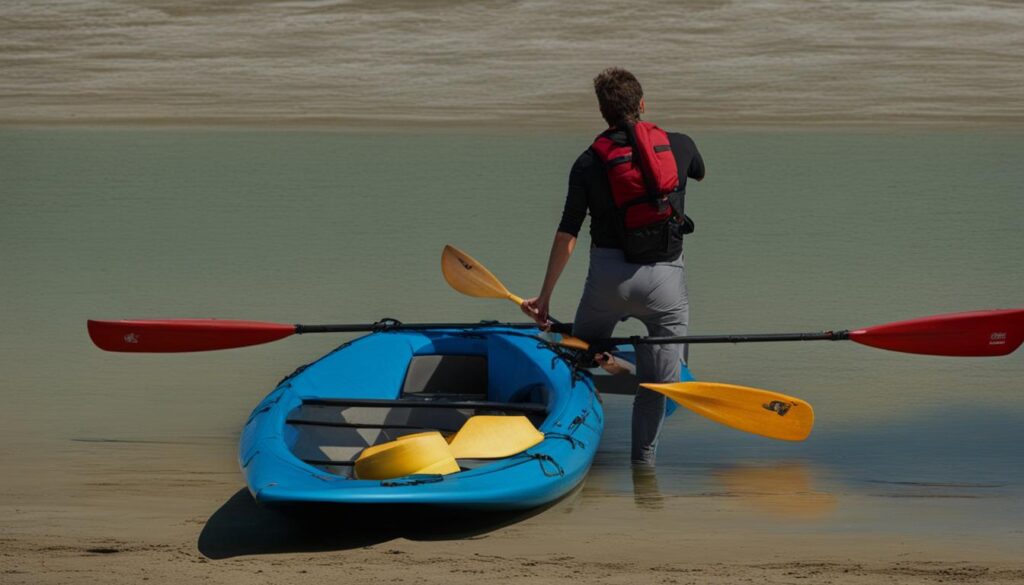Carrying a kayak by yourself can be challenging, especially if you lack height or muscle strength. However, with the right tools and techniques, solo kayak loading can become much easier. Investing in a carry strap, kayak cart, or kayak yoke can greatly facilitate the process. Additionally, opting for a lightweight kayak or an inflatable kayak can make transportation more manageable. It’s important to work within your physical limitations and choose the right method based on your kayak type.
Key Takeaways:
- Invest in a carry strap, kayak cart, or kayak yoke to make solo kayak loading easier.
- Consider using a lightweight or inflatable kayak for more manageable transportation.
- Work within your physical limitations and choose the right method based on your kayak type.
- Properly loading and securing the kayak is essential for safe transportation.
- Practice and utilizing the right equipment will make solo kayak loading a seamless process.
How to Carry a Kayak by Yourself
Carrying a kayak alone may seem daunting, but with the right techniques and tools, it can be done easily and safely. Whether you have a sit-inside kayak or a sit-on-top kayak, there are specific methods you can employ to make the task more manageable for one person.
For a sit-inside kayak: Lift the kayak and rest the cockpit rim on your shoulder. This allows you to distribute the weight evenly and provides stability while carrying. Keep your back straight, engage your leg muscles, and squat down to maintain proper body mechanics.
For a sit-on-top kayak: It is best to carry it under your arm, holding onto the sides of the kayak. This method provides a secure grip and allows for easier maneuverability. Remember to use your leg muscles and maintain proper posture to avoid strain.
Additionally, utilizing solo kayak loading tools can greatly assist in carrying your kayak by yourself. Consider investing in a shoulder strap, kayak cart, or kayak yoke. These tools provide additional support and make the task more effortless. With the right technique and tools, you can confidently transport your kayak without relying on others.

Benefits of Using Solo Kayak Loading Tools
When it comes to solo kayak loading, having the right tools can make a significant difference. Here are some benefits of using solo kayak loading tools:
- Shoulder Strap: A shoulder strap evenly distributes the weight of the kayak and allows for hands-free carrying, offering convenience and comfort.
- Kayak Cart: A kayak cart with wheels provides easy transport over various terrains, reducing the strain on your body and making it effortless to move your kayak from your vehicle to the water.
- Kayak Yoke: A kayak yoke is a device that supports the weight of the kayak on your shoulders, making it easier to carry and reducing the risk of injury.
Carrying a kayak by yourself doesn’t have to be a daunting task. With the right techniques and tools, you can transport your kayak effortlessly, enjoying the freedom of solo kayaking adventures.
Table: Comparison of Solo Kayak Loading Tools
| Tool | Benefits |
|---|---|
| Shoulder Strap | Even weight distribution Hands-free carrying |
| Kayak Cart | Easy transport over various terrains Reduces strain on the body |
| Kayak Yoke | Supports weight on the shoulders Reduces the risk of injury |
Using the right technique and tools, you can confidently carry your kayak by yourself, opening up a world of solo kayaking opportunities. Remember to prioritize safety, listen to your body, and enjoy the freedom of exploring the water at your own pace.
How to Transport a Kayak with a Friend
When transporting a kayak with a friend, you can utilize a two-person carry method to make the process easier and more efficient. This method is especially useful when dealing with larger and heavier kayaks, such as tandems or touring kayaks. By distributing the weight between two individuals, you can minimize strain and avoid potential injuries. Here’s how you can transport a kayak with a friend:
- Both individuals should stand on the same side of the kayak, with one person holding the stern and the other person holding the bow.
- Using the grab handles located at the bow and stern, lift the kayak off the ground, ensuring a secure grip.
- Communicate and coordinate your movements to maintain balance and stability while carrying the kayak.
- Walk in sync with your partner, taking small steps and adjusting your pace to maintain control.
- When setting the kayak down, ensure that both individuals release their grip simultaneously and gently lower the kayak to the ground.
Remember, this two-person carry method allows for transporting a fully-laden kayak without the need to flip it on its side. It’s important to communicate effectively and work in sync with your partner to ensure a smooth and safe transportation experience.
Advantages of Two-Person Carry
The two-person carry method offers several advantages for transporting a kayak:
- Shared weight: By distributing the weight between two individuals, you reduce the strain on any one person.
- Improved balance: Having one person at the stern and another at the bow helps maintain balance and stability while carrying the kayak.
- Efficiency: With two people working together, the loading and unloading process can be completed more quickly and smoothly.
- Reduced risk of injury: By sharing the load, you minimize the risk of strain or injury caused by lifting a heavy kayak alone.
By employing the two-person carry method, you and your friend can transport your kayaks with ease and confidence, allowing you to focus on enjoying your paddling adventures.
| Pros | Cons |
|---|---|
| Shared weight reduces strain on individuals | Requires coordination and communication |
| Improved balance and stability | May not be suitable for narrow or uneven terrain |
| Quicker loading and unloading process | Requires the availability of a second person |
| Minimized risk of injury | Not suitable for solo paddlers |
How to Transport a Kayak on a Roof Rack
Transporting a kayak on a roof rack is a popular and convenient method for solo paddlers. By utilizing a roof rack system, such as J-style racks, saddles, or stackers, you can securely hold your kayak on top of your vehicle, allowing for easy transportation to your desired paddling destination.
When loading your kayak onto the roof rack, it’s important to take precautions to ensure a safe and secure fit. If possible, it’s recommended to have another person assist you in lifting and positioning the kayak onto the roof rack. However, if you’re alone, there are several methods and tools you can use to make the process easier.
One option is to invest in a lift system specifically designed for solo kayak loading. These systems use mechanical devices or pulley systems to help lift the kayak onto the roof rack without straining your back or risking damage to your vehicle. Another alternative is to utilize rolling wheels or improvised methods, such as placing the kayak on a towel or blanket and sliding it onto the roof rack.
Once your kayak is loaded onto the roof rack, it’s crucial to secure it properly for safe transportation. Use cam straps to secure the kayak to the roof rack bars, ensuring a tight and stable fit. Additionally, utilize bow and stern straps to anchor the kayak to the front and rear of your vehicle, preventing any movement or shifting while driving. Don’t forget to attach a red flag to the rear of the kayak to ensure visibility of any overhang.

Table: Pros and Cons of Roof Rack Transport
| Pros | Cons |
|---|---|
| Secure and stable transportation | Requires additional equipment (roof rack system) |
| Does not obstruct rearview mirror | Requires physical effort to lift kayak onto roof rack |
| Allows for easy access to rear and trunk of the vehicle | May increase wind resistance and affect fuel efficiency |
| Offers versatility for carrying multiple kayaks or other gear | May limit vehicle clearance in low-height spaces |
Table: Pros and Cons of Roof Rack Transport
Conclusion
Solo kayak loading may seem challenging at first, but with the right knowledge and equipment, it can become a straightforward process. By following this step-by-step guide and utilizing tools such as carry straps, kayak carts, or roof racks, you can safely and efficiently transport your kayak by yourself.
Consider your physical limitations and choose the right technique for your kayak type. Remember to maintain proper body mechanics and engage your leg muscles to prevent strain and injury. With practice and the right equipment, solo kayak loading will become a seamless part of your kayaking adventures.
Investing in single person kayak loading systems, such as carry straps and kayak carts, can greatly simplify the process and make it more manageable. Additionally, using roof racks with secure kayak loading attachments is a popular method for solo paddlers.
Enjoy Hassle-Free Kayak Transportation
With these tips for one-person kayak loading, you’re ready to hit the water with ease. Don’t let the logistics of transportation hold you back from enjoying your kayaking adventures. Whether you’re headed to a serene lake or tackling thrilling rapids, you can have a hassle-free experience by mastering the art of solo kayak loading.
FAQ
What tools can I use to make solo kayak loading easier?
Investing in a carry strap, kayak cart, or kayak yoke can greatly facilitate the process of carrying a kayak by yourself.
Are there any techniques for carrying a kayak alone?
For a sit-inside kayak, you can lift it and rest the cockpit rim on your shoulder. For a sit-on-top kayak, it’s best to carry it under your arm. Squat down, keep your back straight, and engage your leg muscles for proper body mechanics.
How can I transport a kayak with a friend?
One person can hold the stern while the other person holds the bow. This technique is useful for larger and heavier kayaks and allows for carrying a fully-laden kayak without flipping it on its side.
What is the best method for transporting a kayak on a roof rack?
Using a roof rack system, such as J-style racks, saddles, or stackers, can securely hold the kayak on top of the vehicle. It’s important to properly load the kayak onto the roof rack and secure it with straps for safe transportation.
How can I make solo kayak loading easier?
By following the step-by-step guide and utilizing tools such as carry straps, kayak carts, or roof racks, you can safely and efficiently transport your kayak by yourself.





